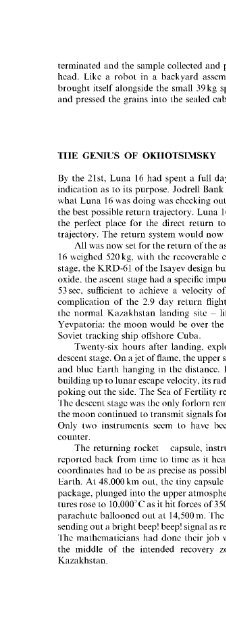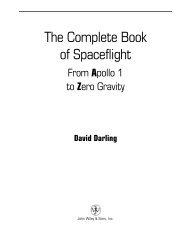Soviet and Russian Lunar Exploration
Soviet and Russian Lunar Exploration
Soviet and Russian Lunar Exploration
You also want an ePaper? Increase the reach of your titles
YUMPU automatically turns print PDFs into web optimized ePapers that Google loves.
terminated <strong>and</strong> the sample collected <strong>and</strong> put into the container attached to the drill<br />
head. Like a robot in a backyard assembly shop, the drill head jerked upwards,<br />
brought itself alongside the small 39 kg spherical recovery capsule, turned it round<br />
<strong>and</strong> pressed the grains into the sealed cabin, which was then slapped shut.<br />
THE GENIUS OF OKHOTSIMSKY<br />
By the 21st, Luna 16 had spent a full day on the moon. There was still no official<br />
indication as to its purpose. Jodrell Bank reported still more strong signals. In fact,<br />
what Luna 16 was doing was checking out its exact l<strong>and</strong>ing coordinates so as to give<br />
the best possible return trajectory. Luna 16 had l<strong>and</strong>ed at the lunar equator at 56°E,<br />
the perfect place for the direct return to Earth on Dmitri Okhotsimsky's passive<br />
trajectory. The return system would now be put to the test.<br />
All was now set for the return of the ascent stage to Earth. The top stage of Luna<br />
16 weighed 520 kg, with the recoverable cabin. There was one engine on the ascent<br />
stage, the KRD-61 of the Isayev design bureau. Burning 245 kg of UDMH <strong>and</strong> nitric<br />
oxide, the ascent stage had a specific impulse of 313 sec <strong>and</strong> could burn just once for<br />
53 sec, sufficient to achieve a velocity of between 2,600 m/sec <strong>and</strong> 2,700 m/sec. A<br />
complication of the 2.9 day return flight was that - to recover the spacecraft in<br />
the normal Kazakhstan l<strong>and</strong>ing site - liftoff would take place out of sight from<br />
Yevpatoria: the moon would be over the Atlantic, where it could be followed by a<br />
<strong>Soviet</strong> tracking ship offshore Cuba.<br />
Twenty-six hours after l<strong>and</strong>ing, explosive bolts were fired above the Luna 16<br />
descent stage. On ajet of flame, the upper stage shot off <strong>and</strong> headed towards the white<br />
<strong>and</strong> blue Earth hanging in the distance. It headed straight up, motor still purring,<br />
building up to lunar escape velocity, its radio pouring out details from the four aerials<br />
poking out the side. The Sea of Fertility returned to the quiet it had known for eons.<br />
The descent stage was the only forlorn reminder of the brief visit. The lower stage on<br />
the moon continued to transmit signals for a couple of days until the battery ran out.<br />
Only two instruments seem to have been carried: a thermometer <strong>and</strong> radiation<br />
counter.<br />
The returning rocket - capsule, instrument container, fuel tanks <strong>and</strong> motors -<br />
reported back from time to time as it headed for a straight nosedive reentry. These<br />
coordinates had to be as precise as possible so as to best predict the l<strong>and</strong>ing spot on<br />
Earth. At 48,000 km out, the tiny capsule separated from the instrument <strong>and</strong> rocket<br />
package, plunged into the upper atmosphere, glowed red <strong>and</strong> then white as temperatures<br />
rose to 10,000°C as it hit forces of 350 G. Helicopters were already in the air as a<br />
parachute ballooned out at 14,500 m. The capsule hit the ground <strong>and</strong> beacons began<br />
sending out a bright beep! beep! signal as rescuers rushed to collect the precious cargo.<br />
The mathematicians had done their job well, for Luna 16 came down 30 km from<br />
the middle of the intended recovery zone, 80 km southeast of Dzhezhkazgan,<br />
Kazakhstan.







